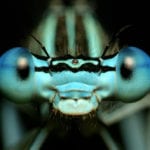 Mysteries
Mysteries  Mysteries
Mysteries  History
History 10 Surprising Stories About the Texas Rangers
 Humans
Humans 10 Philosophers Who Were Driven Mad by Their Own Theories
 Miscellaneous
Miscellaneous 10 Video-Game-Worthy Weapons and Armors from History
 Weird Stuff
Weird Stuff 10 Psychics Who Accurately Predicted Wartime Events
 The Arts
The Arts 10 Pieces of Art Inspired by a Broken Heart
 Health
Health 10 Science Fiction-Sounding New Medical Treatments
 History
History 10 Surprising Facts About the Father of Submarine Warfare
 Space
Space Ten Astonishing New Insights into Alien Worlds
 Weird Stuff
Weird Stuff 10 Bizarre Summer Solstice Rituals Still Practiced Today
 Mysteries
Mysteries Top 10 Haunting Facts About the Ghost Ship MV Alta
 History
History 10 Surprising Stories About the Texas Rangers
 Humans
Humans 10 Philosophers Who Were Driven Mad by Their Own Theories
Who's Behind Listverse?

Jamie Frater
Head Editor
Jamie founded Listverse due to an insatiable desire to share fascinating, obscure, and bizarre facts. He has been a guest speaker on numerous national radio and television stations and is a five time published author.
More About Us Miscellaneous
Miscellaneous 10 Video-Game-Worthy Weapons and Armors from History
 Weird Stuff
Weird Stuff 10 Psychics Who Accurately Predicted Wartime Events
 The Arts
The Arts 10 Pieces of Art Inspired by a Broken Heart
 Health
Health 10 Science Fiction-Sounding New Medical Treatments
 History
History 10 Surprising Facts About the Father of Submarine Warfare
 Space
Space Ten Astonishing New Insights into Alien Worlds
 Weird Stuff
Weird Stuff 10 Bizarre Summer Solstice Rituals Still Practiced Today
10 Formidable Predatory Insects
Warning: ugly bugs We are used to seeing insects as prey animals; everyone eats them, from birds and spiders, to humans. But there are predators among insects as well, and some of them are among Nature’s most perfect killers. I give you ten of the most formidable predatory insects… and be grateful that they don’t come in large sizes!
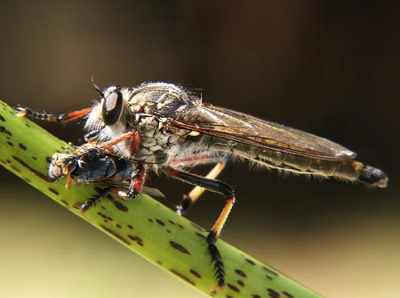
We are all familiar with the house fly, which feeds on decaying organic matter (among other disgusting things), and is pretty much harmless to other insects. However, there are around 120,000 species of flies in the world (many are yet to be discovered) and some of them are accomplished predators. Robber flies are among these; they have extremely sharp eyesight and can fly at high speed, catching other insects in mid air. They have stabbing mouthparts (proboscis) which inject a powerful neurotoxic venom and digestive juices into the victim, liquifying its innards, which the fly sucks afterwards.
Due to this formidable weapon and the robber fly’s devastating attack speed, not even wasps, bees or spiders in their webs are safe from these aerial killers. Robber fly venom is usually harmless to humans, but if captured they can give an extremely painful bite.
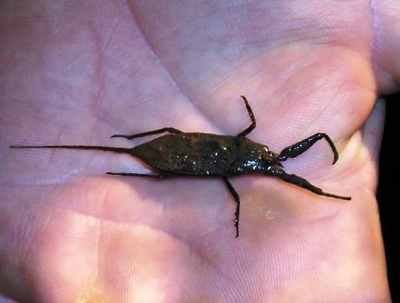
Despite their fearsome appearance and alarming name, water scorpions are actually insects, belonging to the true bug (Hemiptera) group, and completely harmless to humans. However, they are the scourge of small aquatic animals, which they capture with their strong, modified forelegs. Water scorpions are sort of the insect equivalent of a crocodile; they are slow moving ambush predators that snatch any small animal that comes close; mostly, they feed on other aquatic insects such as mosquito larvae and diving beetles, but they have been known to dine on small fish and frogs once in a while.
Although they have wings, their flight muscles are poorly developed and they fly rarely, usually when the ponds or lakes where they live start to dry up and they must find a new residence. As for the long, tail-like projection at the end of their abdomen, it is actually a breathing tube; the water scorpion uses it to collect oxygen from the surface, and can subsequently remain underwater for up to half an hour before it has to breathe again.
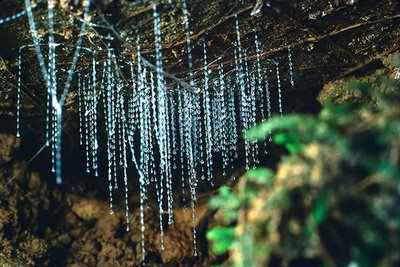
Arachnocampa is a kind of gnat from New Zealand; as an adult, its only goal in life is to mate, and it doesn’t feed at all. However, its larvae are accomplished predators with a most unusual hunting method, which gives the animal its name (Arachnocampa means “spider worm”). They usually live in the ceiling of dark, secluded caves, away from wind currents and sunlight. The larvae spin a nest of silk (produced by themselves) and hang several silk threads from the cave ceiling, around the nest.
Each one of these threads is covered on sticky droplets of mucus, sometimes loaded with venom. The Arachnocampa larva can glow like a firefly, which attracts flying insects such as moths to the sticky threads and to a horrible end. Once the unfortunate insect is caught, the larva tones down its glow, pulls the silk thread up and starts feeding voraciously on the entangled prey, whether it is alive or dead.
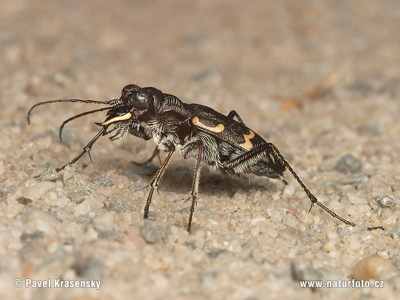
Everyone knows that the fastest land predator is the cheetah, which can reach speeds of 115 kms (71 mph) per hour. Compared to this, a Tiger Beetle is a slowpoke; it can only run at a speed of 8 kms (5 mph) per hour. But if we take its size into account, it is actually the fastest animal in the world! If we could run as fast as the tiger beetle, proportionally to our size, we could reach speeds of almost 500 kms (311 mph) per hour! This speed is so extreme that a running Tiger Beetle must stop constantly to locate prey, since its eyes are unable to process visual information at such high speed.
Tiger Beetles feed on whatever small animal they can subdue; they hunt mostly on land, but are also skilled flyers and have been known to catch other insects in the air too. Their sharp mandibles can easily sever the limbs and body parts of other insects, sometimes bigger than the Tiger Beetle itself. There are many species of Tiger Beetle and they are among the most abundant insect predators, being extremely useful to humans as they help control pests. The larvae of these beetles are also fearsome predators, but instead of chasing their prey, they prefer to wait in ambush, hidden underground, and capture any passing insect with their enormous jaws.
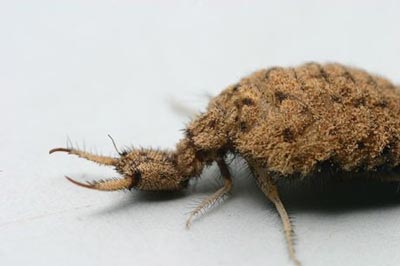
Adult antlions look rather like damselflies, and although some species hunt smaller flying insects, most of them prefer to feed on pollen and nectar. Antlion larvae, on the other hand, are deadly insect predators, and just like Arachnocampa, they have developed a most amazing trick to capture prey. They live in sandy places, where they dig a funnel-shaped pit, cleverly designed so that no insect can climb its steep walls. The antlion then buries itself in the bottom of the pit. Whenever an unfortunate insect (usually an ant) steps on the edge of the pit, the sand collapses and the victim falls to the bottom, and into the antlion larva’s deadly jaws.
Sometimes, an ant will escape the larva and attempt to climb the walls of the pit; in this case, the antlion has another trick up its sleeve; it throws jets of sand to the ant, so that it slips back into the pit’s bottom. Once the antlion larva has secured its prey, it sucks its body fluid with the tooth-like projections of its jaws, and then throws the dry carcass out of the pit.
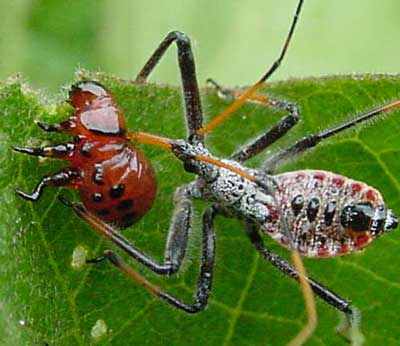
Assassin bugs are among Nature’s most ingenious killers. There are plenty of species, and most of them are harmless to man (although some have excruciatingly painful bites). Often, a species of assassin bug will specialize in a certain kind of prey; for example, some of them feed only on spiders, others prefer ants, etc. They are armed with needle-like mouthparts, which they use to inject lethal saliva into their prey; this saliva liquifies the victim’s innards. (Like many other insects, assassin bugs are unable to feed on solid matter). However, most assassin bugs aren’t fast flyers or runners, so they use trickery to hunt. Some of them cover their bodies with bark, dust, or even dead insects to disguise their appearance and scent, and sneak up on unsuspecting prey.
Spider-hunting assassin bugs often mimic the vibrations produced by insects entangled in a spider web; the spider attacks, thinking that it has caught a tasty meal, only to be killed and devoured itself. Perhaps the most amazing assassin bug is a certain species that feeds on ants. It produces a sugary substance through its abdomen, which serves as bait for the sweet-loving ants. But the sugary substance is also loaded with a powerful tranquilizer; soon, the ant collapses, paralyzed, and the assassin bug can suck its innards without any resistance.
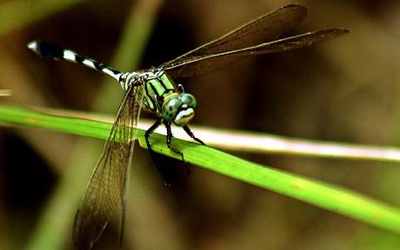
The Dragonfly is the ultimate aerial killer of the insect world; its design is so perfect, that it has remained almost unchanged for the last 300 million years. It is among the fastest flying insects, reaching almost 90 kms (56 miles) per hour (which is even more amazing if we consider its small size and apparent fragility). It can dive-bomb, hover like a helicopter, and even fly backwards, and its enormous eyes, which cover almost all of its head, give it near-360 degree vision, so that no insect escapes its attention.
Dragonflies feed on any flying insects they can catch, and also on spiders, which they capture from their webs. Although they usually hunt and devour prey at high speed in the air, they can also snatch spiders and insects from exposed surfaces. Dragonfly larvae are also formidable predators; they are aquatic, and use their protractile, sharp mouthparts to stab other small animals to death, including small fish, frogs and other dragonfly larvae.

Also known as the driver, safari or army ant, this African species if the only insect known to attack and devour humans, although this happens only very rarely. Siafu ants have very large, sharp jaws and venomous stings, which they use to subdue small animals such as lizards, worms and other insects. However, there have been reports of cows, goats and other domestic animals that were tied to trees or poles by their owners, and, unable to get out of the way, were killed by the Siafu ants. Wild animals avoid ant armies on the move, and some naturalists have claimed that even lions and elephants flee away from them.
There have been reports of attacks on people who couldn’t run away on time, such as unattended babies, sleeping or injured people and at least one drunken man. Also, one tourist that was reported as missing in Tanzania was later found to have been killed by Siafu ants. It is said that these larger victims may not die of envenomation after being stung, but rather of asphyxia, since the attacking ants will go into any body orifice and crawl into the lungs.
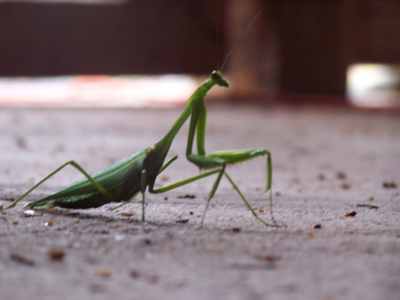
Possibly the best known predatory insect. There are many species of praying mantis, or mantids, around the world, but they are all perfect ambush hunters, armed with long, modified forelegs armed with sharp hooks to capture prey. These forelegs are usually called the “raptorial legs”.
These insects usually stand still, camouflaged, until a smaller insect or animal gets close; then they capture with a lightning fast movement, and start feeding whether the victim is alive or dead.
They are extremely voracious and any kind of prey is good to them; they have been known to capture and devour spiders (including the deadly black widow spider), lizards, small snakes and even birds. They are also infamously prone to cannibalism; females often bite off the head of the male during sex, and feed on the rest of him afterwards. Baby mantids are also known to feed on their siblings when food is scarce. Mantids are skilled flyers but they usually only fly at night, to avoid birds and other larger predators.
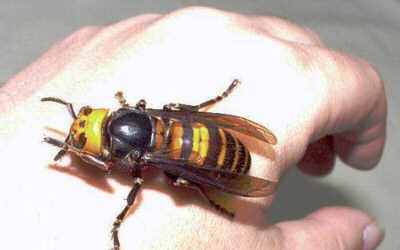
Known as “tiger hornets” in some parts of Asia, these large wasps are relentless hunters that kill any insect they can capture, including other predators such as the praying mantis. They are armed with an incredibly potent venom, and inject great amounts of it; like other hornets, they can sting repeatedly. This venom is strong enough to cause serious illness, and even death, to humans; indeed, they are the most dangerous wild animal in Japan, killing around 40 people per year (more than venomous snakes and bears combined). But the Japanese hornet uses its sting as a defensive weapon only; to kill prey, it uses its sharp jaws to decapitate the victim, and cut its body in small pieces. It then carries the carcass back to the nest, where it chews the dead insect into a soft paste to feed the larvae. The larvae then produce a sugary fluid which is the adult hornet’s main food.
To give you an idea of the destructive power of Japanese hornets, let us only say that a few of them can completely devastate a honey bee colony in a couple of hours, decapitating every single bee in the nest (up to 30,000) one by one. When all the bees are dead, the hornets feed on the honey and then carry the bee larvae, and parts of the adult bee bodies, back to their own nest to feed their larvae. This is the horrible end met by European honeybees (introduced to Japan to increase honey production) when confronted with the “tiger hornet”. But Japanese honey bees are different; they evolved along with the hornet, and have developed an incredible trick to kill the hornet scouts as soon as they find their hive.
Up to 500 bees form a tight ball that engulfs the scout hornet(s) and start vibrating their wing muscles until their body temperature increases up to 47°C. Honey bees can survive this temperature, but hornets cannot; they are basically fried alive by the bees. With the scouts dead, the hornet colony never finds out about the location of the honey bee nest. Even the most formidable predatory insect has to meet its match one day…
